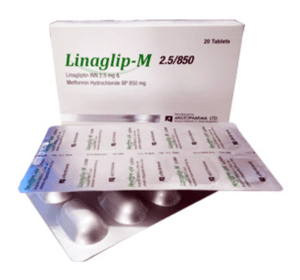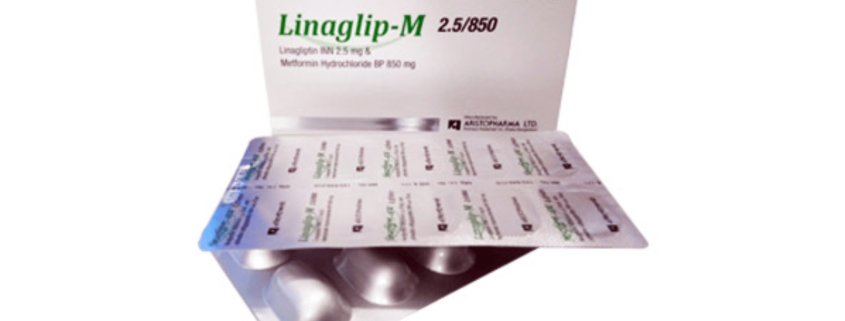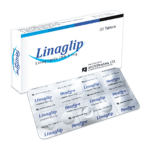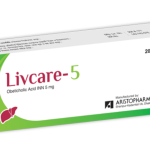Linaglip-M (Linagliptin + Metformin Hydrochloride)
Therapeutic Group : Antidiabetic Oral

Presentation:
Linaglip-M 2.5/500 Tablet: Each film coated tablet contains Linagliptin INN 2.5 mg & Metformin Hydrochloride BP 500 mg.
Linaglip-M 2.5/850 Tablet: Each film coated tablet contains Linagliptin INN 2.5 mg & Metformin Hydrochloride BP 850 mg.
Linaglip-M 5/1000 ER Tablet: Each film coated tablet contains Linagliptin INN 5 mg & Metformin Hydrochloride BP 1000 mg extended release.
Pharmacology:
Linaglip-M combines 2 antihyperglycemic agents (combination of Linagliptin, a DPP-4 inhibitor & Metformin, a member of the biguanide class) with complementary mechanisms of action to improve glycemic control in patients with type 2 diabetes mellitus.
Linagliptin: Linagliptin is an inhibitor of DPP-4, an enzyme that degrades the incretin hormones glucagon-like peptide-1 (GLP-1) and glucose-dependent insulinotropic polypeptide (GIP). Thus, Linagliptin increases the concentrations of active incretin hormones, stimulating the release of insulin in a glucose-dependent manner and decreasing the levels of glucagon in the circulation. Both incretin hormones are involved in the physiological regulation of glucose homeostasis. Incretin hormones are secreted at a low basal level throughout the day and levels rise immediately after meal intake. GLP-1 and GIP increase insulin biosynthesis and secretion from pancreatic beta cells in the presence of normal and elevated blood glucose levels. Furthermore, GLP-1 also reduces glucagon secretion from pancreatic alpha cells, resulting in a reduction in hepatic glucose output.
Metformin: Metformin lowers both basal and postprandial plasma glucose. It does not stimulate insulin secretion and therefore does not produce hypoglyceamia or increased weight gain. Metformin may exert its glucose-lowering effect via four mechanisms:
– by reduction of hepatic glucose production through inhibition of gluconeogenesis and glycogenolysis;
– in muscle, by modestly increasing insulin sensitivity, improving peripheral glucose uptake and utilization;
– by delaying intestinal glucose absorption;- stimulate intracellular glycogen synthesis by acting on glycogen synthase and increase the transport capacity of glucose transporters (GLUT-1 & GLUT-4)
Indications:
Linaglip-M is indicated as an adjunct to diet and exercise to improve glycemic control in adults with type 2 diabetes mellitus when treatment with both Linagliptin and Metformin is appropriate. Combination of Linagliptin and Metformin is not recommended for treatment of type 1 diabetes or diabetic ketoacidosis and has not been studied in patients with a history of pancreatitis.
Dosage & Administration:
Recommended starting dose for 2.5/500 & 2.5/850 mg tablet:
- Patients not currently treated with Metformin: Initiate treatment with Linaglip-M 2.5/500 tablet twice daily.
- Patients already treated with Metformin: If patient is taking Metformin 500 mg tablet twice daily, then give him/her Linaglip-M 2.5/500 tablet twice daily. If patient is taking Metformin 850 mg tablet twice daily, then give him/her Linaglip-M 2.5/850 tablet twice daily.
- Patients already treated with Linagliptin and Metformin individual components: May be switched to Linaglip-M containing the same doses of each component
- Maximum recommended dose: 2.5 mg Linagliptin/1000 mg Metformin tablet twice daily.
Recommended starting dose for 5/1000 mg ER tablet:
- In patients currently not treated with metformin: Initiate Linaglip-M 5/1000 ER tablet once daily with a meal
- In patients already treated with metformin: Start Linaglip-M 5/1000 ER tablet once daily with a meal
- In patients already treated with linagliptin and metformin or their combination: May be switched to Linaglip-M 5/1000 ER tablet once daily with a meal containing the same doses of each component
Contrainidications:
This combination of Linagliptin & Metformin is contraindicated in patients with renal impairment (e.g., serum creatinine >1.5 mg/dL for men, >1.4 mg/dL for women, or abnormal creatinine clearance), which may also result from conditions such as cardiovascular collapse (shock), acute myocardial infarction, and septicemia. This combination is also contraindicated in case of acute or chronic metabolic acidosis, including diabetic ketoacidosis. Diabetic ketoacidosis should be treated with insulin. In case of a history of hypersensitivity reaction to Linagliptin, such as anaphylaxis, angioedema, exfoliative skin conditions, urticaria, or bronchial hyperreactivity. It is also contraindicated in case of hypersensitivity to Metformin.
Warning & Precautions:
Lactic acidosis: Warn against excessive alcohol use. Linagliptin & Metformin combination is not recommended in hepatic impairment or hypoxic states and is contraindicated in renal impairment. Ensure normal renal function before initiating and at least annually thereafter.
Hypoglycemia: When used with an insulin secretagogue (e.g., sulfonylurea (SU)) or insulin, consider lowering the dose of the insulin secretagogue or insulin to reduce the risk of hypoglycemia. There have been postmarketing reports of serious hypersensitivity reactions in patients treated with Linagliptin (one of the components of Linagliptin & Metformin combination) including anaphylaxis, angioedema, and exfoliative skin conditions. In such cases, promptly discontinue Linagliptin & Metformin combination, assess for other potential causes, and institute appropriate monitoring and treatment, and initiate alternative treatment for diabetes.
Vitamin B12 deficiency: Metformin may lower vitamin B12 levels. Monitor hematologic parameters annually.
Arthralgia: Severe and disabling arthralgia has been reported in patients taking DPP-4 inhibitors. Consider as a possible cause for severe joint pain and discontinue drug if appropriate.
Macrovascular outcomes: No conclusive evidence of macrovascular risk reduction with Linagliptin & Metformin combination or any other antidiabetic drug.
If pancreatitis is suspected, promptly discontinue Linagliptin & Metformin combination
Side effects:
The most common side effects of this combination of Linagliptin & Metformin are weakness or tiredness, unusual muscle pain, breathing in trouble, nausea, vomiting, diarrhea, dizziness. Adverse reactions reported in >5% of patients treated with Linagliptin & Metformin combination and more commonly than in patients treated with placebo are nasopharyngitis and diarrhea. Hypoglycemia was more commonly reported in patients treated with the combination of Linagliptin & Metformin and SU compared with those treated with the combination of SU and Metformin.
Drug interaction:
Drug Interactions with Metformin
Cationic Drugs: Cationic drugs (e.g., amiloride, digoxin, morphine, procainamide, quinidine, quinine, ranitidine, triamterene, trimethoprim, or vancomycin) that are eliminated by renal tubular secretion theoretically have the potential for interaction with Metformin by competing for common renal tubular transport systems. Although such interactions remain theoretical (except for cimetidine), careful patient monitoring and dose adjustment of Linagliptin & Metformin combination and/or the interfering drug is recommended in patients who are taking cationic medications that are excreted via the proximal renal tubular secretory system.
Carbonic Anhydrase Inhibitors: Topiramate or other carbonic anhydrase inhibitors (e.g., zonisamide, acetazolamide or dichlorphenamide) frequently decrease serum bicarbonate and induce non-anion gap, hyperchloremic metabolic acidosis. Concomitant use of these drugs may induce metabolic acidosis. Use these drugs with caution in patients treated with Linagliptin & Metformin combination, as the risk of lactic acidosis may increase.
Alcohol: Alcohol is known to potentiate the effect of metformin on lactate metabolism. Warn patients against excessive alcohol intake while receiving combination of Linagliptin & Metformin extended release tablet.
Drug Interactions with Linagliptin
Inducers of P-glycoprotein and CYP3A4 Enzymes: Rifampin decreased Linagliptin exposure, suggesting that the efficacy of Linagliptin may be reduced when administered in combination with a strong P-gp inducer or CYP 3A4 inducer. As Linagliptin & Metformin combination is a fixed-dose combination of Linagliptin and Metformin, use of alternative treatments (not containing Linagliptin) is strongly recommended when concomitant treatment with a strong P-gp or CYP 3A4 inducer is necessary.
Insulin Secretagogues or Insulin
Coadministration of Linagliptin & Metformin extended release tablet with an insulin secretagogue (e.g., sulfonylurea) or insulin may require lower doses of the insulin secretagogue or insulin to reduce the risk of hypoglycemia.
Drugs Affecting Glycemic Control
Certain drugs tend to produce hyperglycemia and may lead to loss of glycemic control. These drugs include the thiazides and other diuretics, corticosteroids, phenothiazines, thyroid products, estrogens, oral contraceptives, phenytoin, nicotinic acid, sympathomimetics, calcium channel blocking drugs, and isoniazid. When such drugs are administered to a patient receiving combination of Linagliptin & Metformin extended-release tablet, the patient should be closely observed to maintain adequate glycemic control. When such drugs are withdrawn from a patient receiving combination of Linagliptin & Metformin extended-release tablet, the patient should be observed closely for hypoglycemia.
Use in special groups:
Pregnancy: Linagliptin & Metformin combination is pregnancy Category B. Linagliptin & Metformin combination tablets should be used during pregnancy only if clearly needed. But the limited data with combination of Linagliptin & Metformin combination extended release tablet use in pregnant women are not sufficient to inform a Linagliptin & Metformin extended-release combination – associated or Linagliptin – associated risk for major birth defects and miscarriage.
Nursing mothers: There is no information regarding the presence of both Linagliptin & Metformin combination and Linagliptin & Metformin combination extended release tablet or Linagliptin in human milk, the effects on the breastfed infant, or the effects on milk production.
USE IN CHILDREN & ADOLESCENTS
Safety and effectiveness of Linagliptin & Metformin combination in pediatric patients under 18 years of age have not been established.
Overdose
Linagliptin
During controlled clinical trials in healthy subjects, with single doses of up to 600 mg of Linagliptin, there were no dose-related clinical adverse drug reactions. There is no experience with doses above 600 mg in humans.
Metformin
Overdose of Metformin has occurred, including ingestion of amounts greater than 50 grams. Hypoglycemia was reported in approximately 10% of cases, but no causal association with Metformin has been established. Lactic acidosis has been reported in approximately 32% of Metformin overdose cases.
Storage:
Store at 25°C and dry place, protect from light. Keep out of the reach of children.
Packing:
Linaglip-M 2.5/500 Tablet: Each box contains 30 tablets in alu-alu blister pack.
Linaglip-M 2.5/850 Tablet: Each box contains 20 tablets in alu-alu blister pack.
Linaglip-M 5/1000 ER Tablet: Each box contains 28 tablets in alu-alu blister pack.



